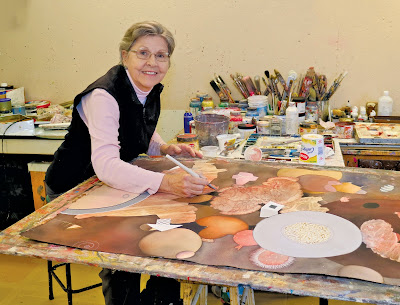Fascinated with the natural world, visual artist Susan Swinand is driven by a limitless curiosity to know about every structure, pattern, form, and force—and the details of how they all operate together. Her work contemplates the questions of chaos and order, freedom and restraint, and tries to find the proper balance between them. How much is too much, she ponders.
This approach bodes rather well for Susan. As the winner of the Sally R. Bishop Best in Show Prize at the 2019 ArtsWorcester Biennial, her recent work is presented in this solo exhibition, Nature Imagined by Susan Swinand.
 |
| Susan Swinand in her studio. |
A longtime faculty member in our studio art program, Susan’s work has been shown widely throughout central New England for many years. Recently, Erin Corrales-Diaz, assistant curator of American art, asked the artist to reflect on her work, her inspiration, and process.¹
EC-D: Throughout your long and successful career, spanning a variety of media, your work consistently engages with dichotomies: metamorphosis and stasis, form and formlessness, and organic and manmade. How does your work complicate these perceived dichotomies, and why does it continue to fascinate?
SS: The more I observe the natural world and our own human nature, the more it seems there is an ideal harmony of opposites or a balance of forces in everything. Nature is both soothing and horrifying, magnificent and disgusting, creative and destructive. If you are looking for truth, you can’t just focus on the beautiful. And you won’t be satisfied just eating the roses on the cake.
 |
| Susan Swinand, All in Together, III, 2019, watercolor and gouache on paper |
EC-D: The natural world seems to be a frequent source of inspiration for you.
SS: I am obsessed with the natural world. I want to know about every structure, pattern, form, and force—and the details of how they all work together. More and more I am pondering the questions of chaos and order, freedom and restraint, and trying to find the proper balance between them. How much is TOO much?
EC-D: One aspect of your work that immediately captivated me was your radical use of materials. For instance, you use watercolors as oils or acrylics and vice versa. What prompted you to defy material expectation and how have these techniques informed your practice?
SS: I taught painting for many years and watercolor painting was always in demand. Most of the watercolor painting that I saw around seemed formulaic and very predictable—more a craft than a process of discovery. I always wanted a painting to feel like it was alive, happening, filled with the unexpected.
Throughout my career I tried to give students obstacles or problems that would force them to find a new way. I wanted watercolor to be a real painting medium and not just pretty, tinted drawings. Watercolor is a bodyless paint and lacks texture so I worked hard to make the medium more physical—scratching, glazing, mixing in dry abrasive media, collage, patterning—anything I could think of to give it presence.
 |
| A gallery view of Nature Imagined by Susan Swinand. |
EC-D: You’ve mentioned that when you approach a painting you are in a “state of not knowing.” There are no preliminary drawings; rather you allow the materials and brushstrokes to guide you. This desire to tap into your imagination seems to draw a parallel with the automatic drawing of surrealism.
SS: Shapes are an important part of my work and can present themselves in the process of working with the wandering of the pen or in a puddle of water left by the shape of the brush. I am subconsciously choosing the shapes that evoke meaning. Years ago, I realized that everything in the universe was created by energy acting on matter. In my work I try to imitate nature’s creative process and put all my energy into my materials to see what they will do. Art for me is about giving FORM to emotion, ideas, or experience.
EC-D: Your paintings often reflect a sense of humor. What is the significance of play and whimsy in your work?
SS: I guess it is just in my nature to love a little laughter. We need it to balance the sadness. Sometimes a shape appears in a painting, and I laugh out loud. It astounds me that an abstract shape can do that. Painting is amazing.
 |
| Susan Swinand, Night Fishing, 2012, watercolor on paper |
Discover more about Susan’s creative process, her friendship with Sally Bishop, and how both nature and imagination inspire her art in a new video, “Susan Swinand: Visual Artist.”
Join a free Virtual Artist Talk on Tuesday, November 10 at 6pm when Erin Corrales-Diaz, assistant curator of American Art, continues the conversation with Susan about her work and making art. Register in advance here. After registering, you will receive a confirmation email containing information about joining the event.
Learn more about Susan and her artistic endeavors and accomplishments by visiting her website.
Nature Imagined by Susan Swinand is on view at WAM through February 7, 2021. The exhibition is organized in partnership with ArtsWorcester
—October 29, 2020
1. This interview originally appeared in the winter/spring 2020 issue of access magazine.





